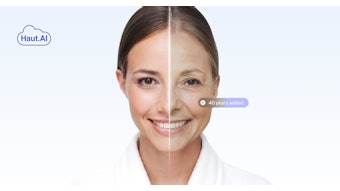
“What steam was to the First Industrial Revolution is what AI will be to the fourth,” McKinsey noteda earlier this year. “And much as coal supply chains and factory infrastructure were the tipping point that enabled steam power to race up the adoption curve, data collection and data infrastructure are doing the same in the fourth.”
As with the wider economy, beauty innovation seems poised to accelerate with new AI-powered tools that allow users to chat with a virtual consultant, reverse engineer products, build new products to a wide array of regulatory, sustainability and retailer requirements, anticipate consumer liking based on reviews of existing similar products, and much more.
This is particularly critical amid emerging regulatory requirements such as MoCRA and ever-changing consumer demands.
These tools, an advancement from legacy systems that rely on Excel tables or cumbersome non-cloud-based databases, can also give a competitive edge to smaller upstart players and early adopters alike.
Here’s what that looks like in practice.
From Consumer Consultant to Product Innovation Platform
The Good Face Project entered the consumer education space with a data-rich, cloud-based solution that allowed shoppers to assess the safety of products based on ingredient compositions.
While the firm was not the first solution to deliver greater transparency, the firm’s cloud-based system was less clunky than earlier solutions in the market.
Since its debut in 2018, The Good Face Project has expanded to a business solution, allowing retailers to create interfaces for shoppers seeking guidance on product selection.
It has also developed solutions for contract manufacturers and ingredient suppliers.
By connecting the entire value chain of beauty, The Good Face Project has now produced a product innovation platform powered by the cloud and AI.
CARA Chat: a ChatGPT for Beauty
The Good Face Project’s new CARA Chat—powered by CARA AI, the company’s proprietary artificial intelligence—is a real-time communication tool similar to ChatGPT but trained solely in beauty-centric natural language.
 CARA AI from The Good Face Project allows beauty pros to converse with a narrowly trained generative AI interface, thereby accelerating the development process and quickly addressing questions and concerns.Good Face
CARA AI from The Good Face Project allows beauty pros to converse with a narrowly trained generative AI interface, thereby accelerating the development process and quickly addressing questions and concerns.Good Face
CARA Chat adds to The Good Face Project’s existing product lifecycle management (PLM) solutions and was built using proprietary data models and information drawn from the company’s existing databases, including ingredient supplier portals.
Clients can also input their own data. That information remains confidential and wholly owned by the customer.
The AI chat system draws from this data and documents in any format to reply to queries about beauty regulations, performance, and information related to the ingredients of a formula or raw material.
The chat tool can, for example, inform a user which components of a shampoo formula have allergenic concerns. To take another example, CARA Chat can also help users determine defensible product claims.
In all cases, The Good Face Project says, answers are precise and instantaneous.
The Good Face Project argues that CARA Chat can help product innovation teams, sales leads and other beauty professionals move quickly.
Reverse Engineering Beauty at Speed
Brands have been reverse engineering products for as long as the industry has existed, whether to create improved competitive SKUs or to generate dupes. However, new tools are making that process easier and faster.
The Good Face Project’s Reverse Engineering Module, for example, purports to speed up the R&D formulation development process by allowing users to upload a full list of ingredients—for instance one copied and pasted from a retailer website—and use that list to recreate the formula by pulling information from a database of more than 40,000 trade-named materials.
 The Good Face Project’s Reverse Engineering Module, for example, purports to speed up the R&D formulation development process by allowing users to upload a full list of ingredients—for instance one copied and pasted from a retailer website—and use that list to recreate the formula by pulling information from a database of more than 40,000 trade-named materials.The Good Face Project
The Good Face Project’s Reverse Engineering Module, for example, purports to speed up the R&D formulation development process by allowing users to upload a full list of ingredients—for instance one copied and pasted from a retailer website—and use that list to recreate the formula by pulling information from a database of more than 40,000 trade-named materials.The Good Face Project
Users can also customize formulas by adjusting concentrations or swapping out materials to increase efficacy or optimize price.
And, for beauty detectives, assessing ingredient compositions against market ingredients can uncover which specific captive materials a competitor is using.
Users of the system can also read the “mood” of product reviews correlated with specific claim benefits or compositions, allowing product developers to anticipate shopper “liking.”
In addition to reverse engineering or benchmarking products, the module can also reportedly help brands and contract manufacturers accelerate ingredient discovery and identify new suppliers.
In all, The Good Face Project believes the module allows teams to arrive at market-ready formulas in seconds.
AI-powered Innovation Begins with Good Data
Underlying The Good Face Project’s technology is the company’s data. Notably, its Ontology Search Module comprises more than 140,000 molecules, including ingredient properties, related research papers, and safety info and regulatory compliance data such as impurity profiles.
 AI tools can reportedly help brands of every scale move more quickly by leveraging accurate, timely data in a user-friendly interface.StratfordProductions
AI tools can reportedly help brands of every scale move more quickly by leveraging accurate, timely data in a user-friendly interface.StratfordProductions
Combined, tools such as these can help brands of every scale move more quickly by leveraging accurate, timely data in a user-friendly interface.
“Identifying 140,000,000 molecules was not the biggest hurdle: the processing and structuring of such a large data graph is what other companies are not able to do today,” says Iva Teixeira, co-founder and CEO of Good Face Project.
“Indeed, we leverage our own proprietary AI, CARA, that is helping us 24/7 to manage our data at an unprecedented speed and efficiency,” adds Lena Skliarova-Mordvinova, cofounder and CTO of Good Face Project.
Further upstream, new AI innovation is reshaping ingredient discovery and adoption.
AI-driven Protein Discovery
Shiru, a company using AI to optimize the discovery, development and scale up of proteins for personal care and other industries, has launched the ProteinDiscovery.ai marketplace, featuring 33 million molecules/protein sequences.
 Using AI models, large datasets and automated biochemistry, users can connect the dots between natural protein sequences and novel applications.Shiru
Using AI models, large datasets and automated biochemistry, users can connect the dots between natural protein sequences and novel applications.Shiru
Using AI models, large datasets and automated biochemistry, users can connect the dots between natural protein sequences and novel applications.
Companies can then use the ProteinDiscovery.ai platform to test those proteins and, if successful, purchase the property rights to these materials in perpetuity for application in product innovation.
In this way, Shiru claims, ProteinDiscovery.ai creates new biobased ingredient intellectual property.
The company claims that this process “can save companies millions of dollars in R&D costs—and years of work,” thereby accelerating personal care innovation by simplifying the search for efficacious ingredients that meet clean label or stability demands.
Shiru has already launched one personal care technology on its own, OleoPro, a structured fat that replaces palm and coconut oil and cocoa butter in personal care.
According to the company, “The highly tunable protein technology powering OleoPro allows oils to be used in new ways to deliver a range of previously impossible functionality for food and consumer products...”
“With ProteinDiscovery.ai we’ve made the world of natural proteins for industrial applications accessible," says Shiru founder and CEO Jasmin Hume, Ph.D. “We’ve even added the ability for users to easily purchase samples, creating the ‘Amazon for proteins.’ We’ve been using AI to identify high-value, novel, scalable proteins for years, fueling our own product development. With significant recent interest from CPGs and ingredients companies alike, we decided to open our toolbox to everyone.”
Firms are also tapping AI to remove bias from skin/age diagnostics.
Unbiased AI Age Analyses
Accurate estimates of chronological age can be assessed by AI simply via hand images and are as accurate as facial analyses, per a new publication from the team behind Haut.AI.
This methodology reportedly overcomes “potential biases that can arise from facial recognition systems due to factors like ethnicity and facial features,” per Haut.AI.
 According to the authors, the use of hand images for accurate age prediction "offers a viable alternative to traditional facial photo methods and promotes fairer AI solutions."Sheilby Macena at Adobe Stock
According to the authors, the use of hand images for accurate age prediction "offers a viable alternative to traditional facial photo methods and promotes fairer AI solutions."Sheilby Macena at Adobe Stock
The publication, in the journal Experimental Dermatology, is titledb “Predicting human chronological age via AI analysis of dorsal hand versus facial images: A study in a cohort of Indian females."
The report details the use of AI models trained on hand images to match the accuracy of facial image chronological age estimates.
By using Indian individuals, the AI model reportedly demonstrated efficacy across a range of skin types, ensuring inclusivity.
The study also revealed key hand age markers including wrinkles, knuckles and bone prominence. Addressing the appearance of these three factors could potentially impact human-perceived aging as well, Haut.AI argues.
“Our research demonstrates that your age can be determined just as accurately from a picture of your hands as from your face,” says Anastasia Georgievskaya, the CEO of Haut.AI. “This not only opens doors for new applications of AI technology but also has the potential to mitigate biases often associated with conventional systems. This aligns perfectly with our commitment to developing fair and responsible AI solutions.”
Beyond AI tech, a number of platforms offer enhanced capabilities for the beauty industry.
Improving the Claims Testing Process
Skinobs' V2.0 supports and reportedly simplifies research projects by connecting beauty professionals with clinical and preclinical test options, laboratories, and/or consultants in a digital platform.
 Skinobs' V2.0 supports and reportedly simplifies research projects by connecting beauty professionals with clinical and preclinical test options, laboratories, and/or consultants in a digital platform.dusanpetkovic1
Skinobs' V2.0 supports and reportedly simplifies research projects by connecting beauty professionals with clinical and preclinical test options, laboratories, and/or consultants in a digital platform.dusanpetkovic1
Taking a matter of minutes, according to Skinobs, key features of the upgraded platform include project management tools, a private integrated messaging system, Q&A support and a simplified interface.
Skinobs offers two platforms dedicated to preclinical assays (in silico, in vitro or ex vivo) and clinical evaluation (in vivo on humans) to reportedly optimize product development in terms of performance, cost, speed and innovation.
The latest platform upgrade comes amid escalating demand for proven efficacy in beauty.
“Testing cosmetics products is at the heart of the beauty industry and is the key to success,” says Anne Charpentier, CEO and founder of Skinobs. “Our objective today is to function as a central hub where laboratories and cosmetics professionals converge. With Skinobs, we strive to facilitate collaboration and communication between these two essential industry entities.”
Suppliers are also making formulating toward claim and label compliance.
A Digital Lab for Easy Compliance
BASF’s Ingredients Revealed upgrade, added to its D’lite digital platform, is designed to enhance access to transparent information on cosmetic formulations.
Users can access ingredient and formulation information using search criteria such as labels, standards and sustainability parameters.
 BASF's Ingredients Revealed "digital lab" concept allows users track formulations' biodegradability and renewable carbon content in real time.BullRun at Adobe Stock
BASF's Ingredients Revealed "digital lab" concept allows users track formulations' biodegradability and renewable carbon content in real time.BullRun at Adobe Stock
This “digital lab” reportedly takes BASF’s D’lite service platform to the next level by helping brands respond to the rising number of standards and labels issued by certifying agencies, regulators and retailers, which ultimately shape shopper choices.
How it works:
- Users browse BASF’s formulation database to identify candidates that meet targeted consumer demands
- Users can add or delete individual ingredients to these preexisting formulas or generate built-from-scratch formulas, all the while tracking the impact of ingredient selection on the formulas' compliance with targeted labels, claims, etc.
- Using this “digital lab” functionality, users can track biodegradability and renewable carbon content in real time
- Notably, users can import their own ingredients
“With our new tool, we enable users to create or upload their own formulations and see changes happen instantly while customizing them,” says Aleksandra Pienczykowska, manager, digital customer channels EMEA, at BASF Care Chemicals. “This way, they get real-time transparency on different criteria which significantly simplifies the development process for formulations.”
FOOTNOTE
bhttps://onlinelibrary.wiley.com/doi/full/10.1111/exd.15045










